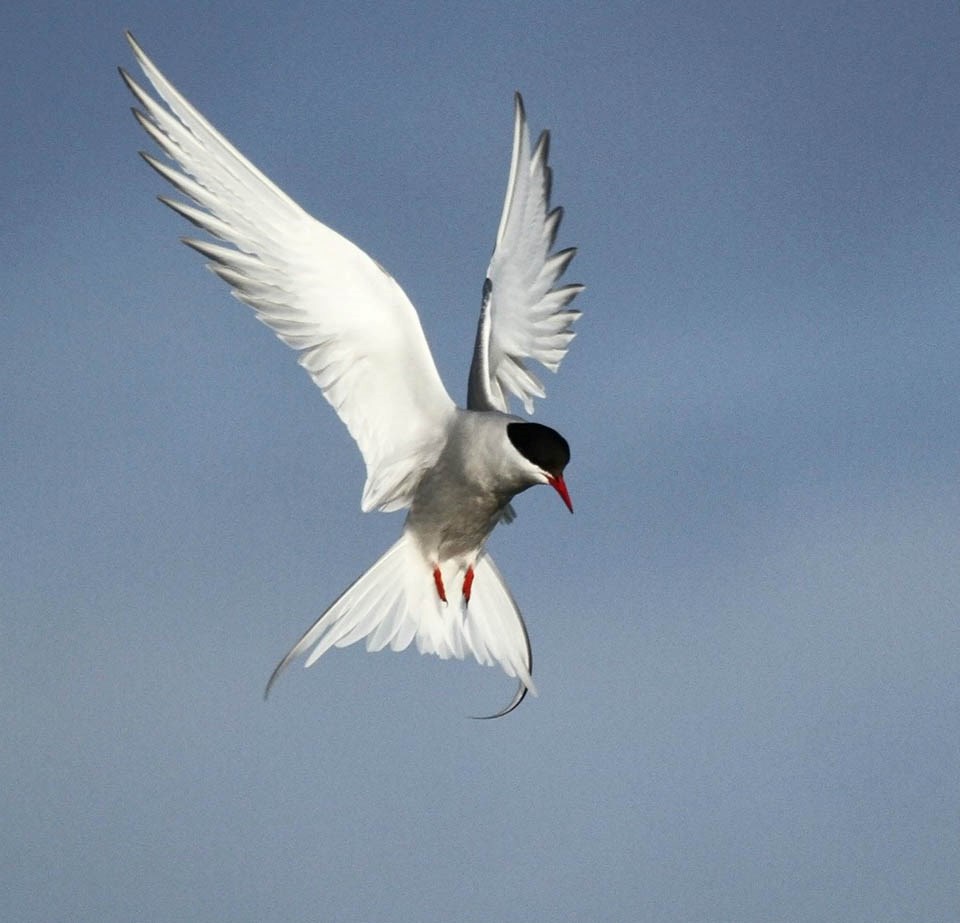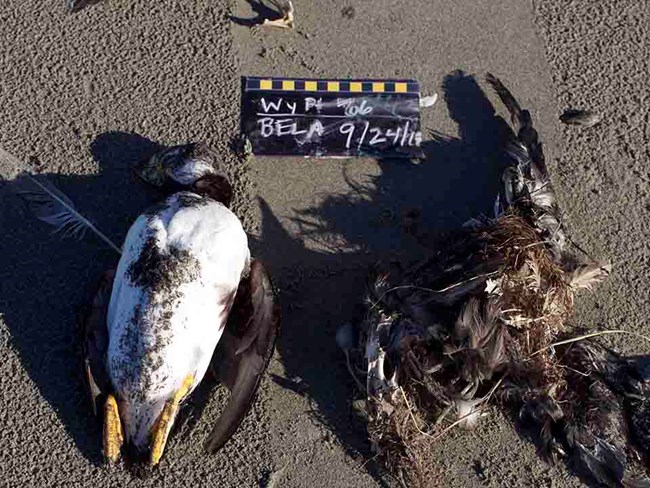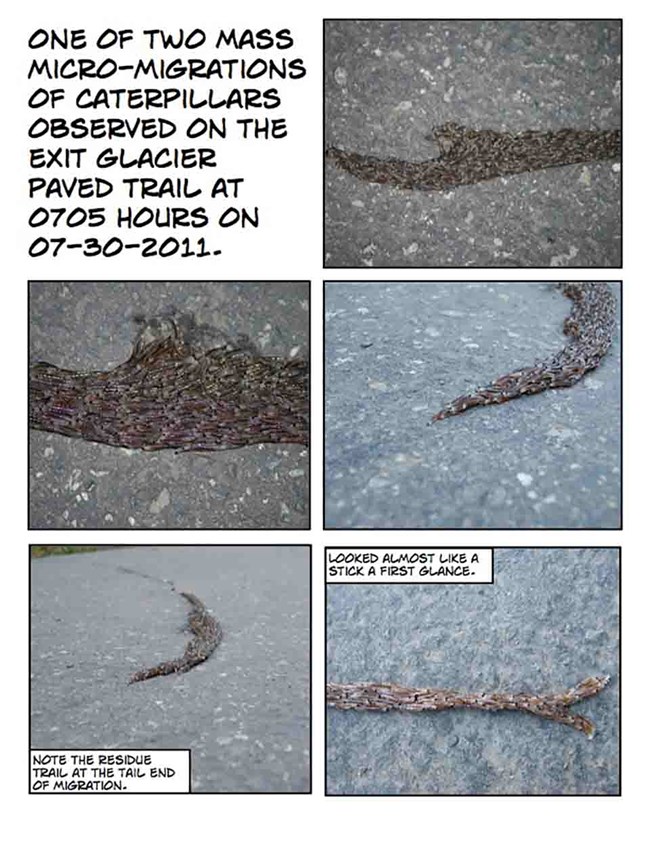Part of a series of articles titled Alaska Park Science - Volume 17, Issue 1. Migration: On the Move in Alaska.
Article
Migration: On the Move in Alaska
By Laura Phillips, Nina Chambers, and Stacia Backensto
National Park Service

NPS/Jared Hughey
Migration encompasses a variety of movements between two areas (Dingle and Drake 2007) and Alaska is well known for some spectacular examples of the phenomenon. Arctic Terns (Sterna paradisaea) nest and raise young in Alaska each summer and then in the fall undergo the longest known animal migration, flying about 15,000 miles (over 24,000 km), to wintering areas in Antarctica (McKnight et al. 2013, Egevang et al. 2010). Caribou (Rangifer tarandus) in northern Alaska perform the longest over-land migration of any terrestrial animal on the planet traveling over 2,000 miles (3,200 km) annually between summer calving grounds and wintering areas where their preferred winter forage, lichen, is plentiful (Fancy et al. 1989, Joly and Cameron 2017). Millions of salmon return from the ocean to the rivers of Alaska each year to spawn, providing a critical food resource for wildlife and people. While these astonishing movements exemplify migration in Alaska, smaller movements of animals on the landscape are equally important to an individual’s survival as well as the integrity of ecosystems.
The daily and seasonal movements of the smallest animals support the function of marine ecosystems in places like Glacier Bay National Park and Preserve. These migrations do not meet the traditional definition of migration as exemplified by long-distance migratory birds, but are similar in function. Tiny marine invertebrates collectively referred to as zooplankton support much of the life in the oceans as prey to fish, whales, and seabirds. Zooplankton exhibit a daily vertical migration within the water column, ascending to shallower waters at night and descending to deeper waters during the day, to avoid some of their many predators (Stich and Lampert 1981). Small forage fish feed primarily on zooplankton and their seasonal movements indicate areas of high plankton productivity as well as important spawning areas. Migratory patterns may change from year to year because of the changes in ocean waters such as temperature, salinity, and freshwater inputs. These changes, in turn, can result in cascading effects within seabird and forage fish populations.

NPS /Stacia Backensto
Changes in patterns of seasonal movements—at large spatial scales or more localized—have far-reaching affects throughout the ecosystem.
For example, with less sea ice, the dark open ocean absorbs more heat from the sun. Warm ocean waters are poor habitat for forage fish that are critical to the survival of seabirds.
Alaska’s largest seabird die-off occurred in the Gulf of Alaska in 2015-2016, affecting hundreds of thousands of Common Murres. The birds had starved because forage fish were largely absent. The forage fish (like capelin, herring, and juvenile pollock) feed on zooplankton, abundant in cold waters.
In the fall of 2017, dead birds washed up on the shores of the Bering and Chukchi seas. Among them were Short-tailed Shearwaters that migrate 9,000 miles (14,400 km) to Australia from Alaska, Northern Fulmars, kittiwakes, murres, auklets, and puffins.
While we don’t know the cause of the recent die off, this is the fourth consecutive year the Bering and Chukchi seas have been exceedingly warm. Warm waters can also trigger toxic algal blooms, which are suspected in some marine mammal deaths in recent years.
Across a landscape as vast and sparsely populated as Alaska, our understanding of the ecology and movement patterns of many species that live here is limited. This is particularly evident in invertebrates, some of which undertake long-distance migrations as observed in well-known insects such as monarch butterflies (Danaus plexippus), though we do know of some very interesting smaller scale insect migrations.

Migrations in the Microwilderness
Jessica Rykken, National Park ServiceWhile we don’t know of any Alaska insects that undergo long-distance migrations, the larvae of some fungus gnats (family Sciaridae) have a remarkable method of traveling en masse to reach their pupation sites. Each larva is small, less than half an inch (about a centimeter) long, but they congregate in columns of up to a thousand or more individuals to form long, snake-like bands up to an inch (several centimeters) across and yards (meters) in length.
The writhing column also has depth because larvae are stacked on top of one another, each secreting a layer of mucus that allows the upper larvae to slide forward over the lower ones, with those in the rear rising to the top layer, much like a conveyor belt. In this manner, the column of fly larvae (maggots) can advance an inch (several centimeters) per minute, leaving a trail of mucus behind it.
Fungus gnat larval aggregations have been observed to travel up to 32 feet (ten meters). The exact reasons behind these mass maggot migrations are still somewhat of a mystery, but it’s hypothesized that the mature larvae are seeking drier ground in which to pupate. One of the migrating fungus gnat species inhabiting Alaska is Sciara militaris, also known as army worms or snake worms. Visitors at Kenai Fjords National Park have been fortunate to observe this migratory phenomenon on multiple occasions on the paved trails at Exit Glacier.
Another challenge is piecing together ancient movements of animals now extinct such as investigating the colonization of Alaska during periods when the Bering Land Bridge was present. In this issue of Alaska Park Science, readers will learn how scientists discover the stories of animals’ movements across Beringia in “Duck-billed Dinosaurs, Ancient Environments, and Cretaceous Beringia,” and “Pleistocene Megafauna in Beringia.” People also travelled across Beringia and developed specialized methods for hunting Pleistocene megafauna like steppe bison (Bison priscus) and caribou. “A Survey of Human Migration through Time” describes the movements of the first Alaskans over thousands of years. A more recent human migration is described in “The Klondike Gold Rush.”
Many Alaskans still rely on migratory animals to support subsistence lifestyles. Caribou and salmon have figured prominently in Alaska Native culture for thousands of years. “History, Purpose, and Status of Caribou Movements” and “Future Challenges for Salmon and Freshwater Ecosystems” discuss how changes in the populations (of caribou and salmon respectively) may affect today’s Alaskan residents. As seasonal ice conditions change with climate warming, longer periods of ice-free water during the year has implications for the marine mammals using Pacific Arctic ecosystems. “Seasonal Sea Ice and Arctic Migrations of Beluga Whale” discusses the impacts of these changes. Similar reductions in ice associated with the retreat of tidewater glaciers impact the movements of seals as described in “Influence of Spring Prey Pulses on the Seasonal Distribution and Migrations of Pinipeds.”
As incredible migration is at many scales and across many taxa, birds are still the stars of long-distance migration. Over 80% of more than 300 resident birds connect Alaska to six continents through their migrations (Gibson et al. 2018). While Arctic Terns fly the farthest, birds like Bar-tailed Godwits (Limosa lapponica) and Bristle-thighed Curlews (Numenius tahitiensis) exhibit astounding non-stop flights of 2,500-6,000 miles (4,000-10,000 km) across open ocean (Gill et al. 2005, Marks and Redmond 1994). Or the Pacific Golden-Plover (Pluvialis fulva) that can cover its 3,000-mile (4,800 km) migration in as little as three days at speeds of up to 185 miles/hour (Johnson et al. 2011). The coastal areas of Northwest Alaska provide staging areas where tens of thousands of shorebirds congregate during migration to gorge on invertebrates before continuing their long flights across the globe (Alaska Shorebird Group 2008). Bird migrations highlighted in this issue include, “Statewide Movements of Non-territorial Golden Eagles in Alaska During the Breeding Season” and “Connecting Taiga to Tropics: Swainson’s Thrush as a Model for Nearctic-Neotropical Migration in Alaska.”
Alaska’s national parklands, encompassing nearly 54 million acres (22 million hectares), play an increasingly important role in conserving migratory animals as human development continues to fragment the landscape outside protected areas. However, as detailed in this issue, animals do not recognize park boundaries and face ever-increasing threats to their ability to complete their migratory journeys. Migration at all scales, from local to hemispherical, are a fundamental part of Alaska’s landscape. Read more about this in “Bridging the Boreal” about landscape linkages and “Migration’s Foundation” about ecological intactness.
Many Alaskans still rely on migratory animals to support subsistence lifestyles. Caribou and salmon have figured prominently in Alaska Native culture for thousands of years. “History, Purpose, and Status of Caribou Movements” and “Future Challenges for Salmon and Freshwater Ecosystems” discuss how changes in the populations (of caribou and salmon respectively) may affect today’s Alaskan residents. As seasonal ice conditions change with climate warming, longer periods of ice-free water during the year has implications for the marine mammals using Pacific Arctic ecosystems. “Seasonal Sea Ice and Arctic Migrations of Beluga Whale” discusses the impacts of these changes. Similar reductions in ice associated with the retreat of tidewater glaciers impact the movements of seals as described in “Influence of Spring Prey Pulses on the Seasonal Distribution and Migrations of Pinipeds.”
As incredible migration is at many scales and across many taxa, birds are still the stars of long-distance migration. Over 80% of more than 300 resident birds connect Alaska to six continents through their migrations (Gibson et al. 2018). While Arctic Terns fly the farthest, birds like Bar-tailed Godwits (Limosa lapponica) and Bristle-thighed Curlews (Numenius tahitiensis) exhibit astounding non-stop flights of 2,500-6,000 miles (4,000-10,000 km) across open ocean (Gill et al. 2005, Marks and Redmond 1994). Or the Pacific Golden-Plover (Pluvialis fulva) that can cover its 3,000-mile (4,800 km) migration in as little as three days at speeds of up to 185 miles/hour (Johnson et al. 2011). The coastal areas of Northwest Alaska provide staging areas where tens of thousands of shorebirds congregate during migration to gorge on invertebrates before continuing their long flights across the globe (Alaska Shorebird Group 2008). Bird migrations highlighted in this issue include, “Statewide Movements of Non-territorial Golden Eagles in Alaska During the Breeding Season” and “Connecting Taiga to Tropics: Swainson’s Thrush as a Model for Nearctic-Neotropical Migration in Alaska.”
Alaska’s national parklands, encompassing nearly 54 million acres (22 million hectares), play an increasingly important role in conserving migratory animals as human development continues to fragment the landscape outside protected areas. However, as detailed in this issue, animals do not recognize park boundaries and face ever-increasing threats to their ability to complete their migratory journeys. Migration at all scales, from local to hemispherical, are a fundamental part of Alaska’s landscape. Read more about this in “Bridging the Boreal” about landscape linkages and “Migration’s Foundation” about ecological intactness.
REFERENCES
Alaska Shorebird Group. 2008.
Alaska Shorebird Conservation Plan. Version II. Alaska Shorebird Group, Anchorage, AK.
Dingle, H. and V. A. Drake. 2007.
What is migration? Bioscience 57:113-121.
Egevang, C., I. J. Stenhouse, R. A. Phillips, A. Petersen, J. W. Fox, and J. R. D. Silk. 2010.
Tracking of Arctic terns Sterna paradisaea reveals longest animal migration. Proceeding of the National Academy of Sciences 107: 2078-2081.
Fancy, S. G., L. F. Pank, K. R. Whitten, and W. L. Regelin. 1989.
Seasonal movements of caribou in arctic Alaska as determined by satellite. Canadian Journal of Zoology 67: 644-650.
Gibson, D. D., L. H. DeCicco, R. E. Gill Jr., S. C. Heinl, A. J. Lang, T. G. Tobish Jr., and J. J. Withrow. 2018.
Checklistof Alaska Birds. University of Alaska Museum, Fairbanks.
Gill, Jr, R. E., T. Piersma, G. Hufford, R. Servranckx, and A. Riegen. 2005.
Crossing the ultimate ecological barrier: evidence for an 11 000-km-long nonstop flight from Alaska to New Zealand and eastern Australia by bar-tailed godwits. The Condor 107(1): 1-20.
Johnson, O. W., L. Fielding, J. W. Fox, R. S. Gold, R. H. Goodwill, and P. M. Johnson. 2011.
Tracking the migrations of Pacific Golden-Plovers (Pluvialis fulva) between Hawaii and Alaska: New insight on flight performance, breeding ground destinations, and nesting from birds carrying light level geolocators. Wader Study Group Bull. 118(1): 26-31.
Joly, K. and M. D. Cameron. 2017.
Caribou vital sign annual report for the Arctic Network Inventory and Monitoring Program: September 2015-August 2016. Natural Resource Report NPS/ARCN/NRR—2017/1398. National Park Service, Fort Collins, Colorado.
Marks, J. S. and R. L. Redmond. 1994.
Migration of Bristle-thighed Curlews on Laysan Island: timing, behavior and estimated flight range. The Condor 1: 316-330.
McKnight, A., A. J. Allyn, D. C. Duffy, and D. B. Irons. 2013.
‘Stepping stone’ pattern in Pacific Arctic Tern migration reveals the importance of upwelling areas. Marine Ecological Progress Series 491: 253-264.
Stich, H. B. and W. Lampert. 1981.
Predator evasion as an explanation of diurnal vertical migration by zooplankton. Nature 293: 396.
Last updated: February 11, 2019
